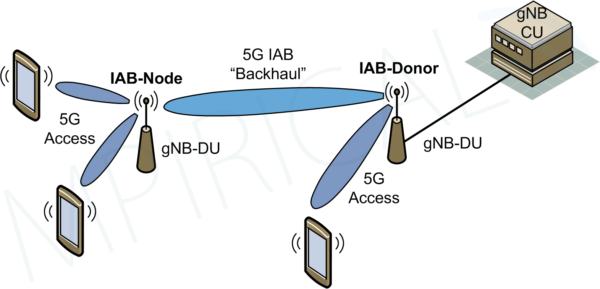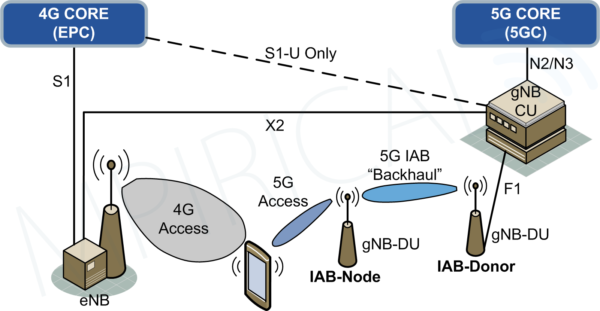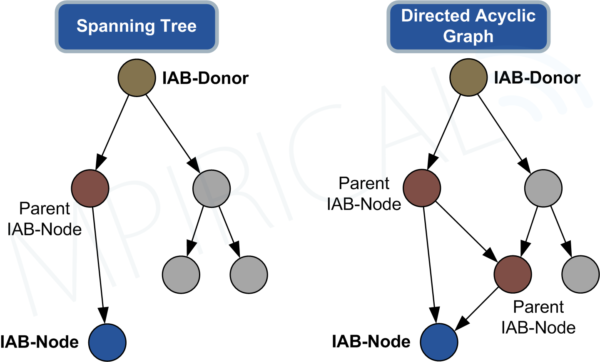
Integrated Access and Backhaul for 5G
The roll-out of 5G services worldwide has reignited the requirement for small cells to provide targeted capacity and coverage. However, the practical implementation of deploying small cells and the required transport network infrastructure to support them is challenging. There are many backhaul options available to service providers, such as fibre optic and E-band (~75GHz) microwave link. However, 3GPP have identified a feature called IAB (Integrated Access and Backhaul) which aims to provide another alternative, as well as enhancing other potential deployment use-cases and scenarios.
Presently, many networks are still focusing on enhancing their NSA (Non-Standalone) deployments, however for some, the goal is the roll-out SA (Standalone) 5G. If my experiences from delivering our 5G System Engineering and 5G Air Interface courses are an indicator, it’s clear that many service providers are already looking forward to 3GPP Release 16 and Release 17 features, realizing that some of these future features will assist their deployment strategies. Inevitably, during my training sessions there are many discussions on the Release 16 IAB (Integrated Access and Backhaul) feature.
Integrated Access and Backhaul
Every service provider involved with rolling out 5G cells knows fibre optic transport connectivity to a cell site is vital to maximize the potential of 5G. As such, month by month, more and more fibre is being placed in the ground. This comes with various challenges, never mind the costs involved. The challenge with small cells is that these are typically deployed in already densely populated areas where the connectivity of fibre may be an issue. One obvious solution it to utilize 5G to backhaul 5G user traffic. Whilst this concept is not new, the key is the implementation within the 3GPP 5G standards.

Figure 1 illustrates the basic concept of IAB. At the heart of the concept is the deployment of C-RAN (Centralized RAN) and the functional split of the gNB (New Radio Node B) into a CU (Centralized Unit) with multiple DUs (Distributed Units). IAB defines the IAB-Donor which supports both 5G access from devices, as well as the 5G IAB Backhaul. Thus, enabling the IAB-Node(s) to get connectivity. These IAB-Nodes include the gNB-DU functionality and thus provides 5G Access.
IAB Implementation
One question I’m frequently asked is whether the concept of IAB can only be used for SA (Standalone) 5G operation. The answer is no, the IAB concept would work equally well for NSA (Non Standalone) operation. In so doing, the 5G access for the NSA device could be provided by an IAB-Node. In Figure 2, the device is in NSA operation, i.e. utilizing the EPC (Evolved Packet Core). However, in my example the IAB-Node itself, which also has a USIM (Universal Subscriber Identity Module) or eSIM (Embedded SIM) is operating in SA mode, i.e. it’s utilizing the 5GC (5G Core).

When it comes to the technical aspects, other discussion relates to the spectrum used for the 5G IAB backhaul link. Once again, it is very flexible, supporting both “in-band” (using the same band as the 5G access) or “out-of-band” (using a different band). These discussions typically focus on spectrum availability, interference constraints, and the typical issues of TDD (Time Division Duplexing) operation. The answer is dependent on the service provider’s implementation, as well as the predicted capacity requirements of the IAB-Node(s).
Previously, I’ve only illustrated a single hop, i.e. one IAB-Node. In reality, systems are being designed with multi-hop capabilities, which provides more range, as well as the capability to “hop” around obstacles, which may be fixed, or adapt based on changes to the physical environment, e.g. seasonal foliage or vehicles e.g. buses/trucks impacting the signal. In addition, if utilizing the High-band frequencies (which have limited range), then multi-hop proves to be invaluable. Typically, when describing multi-hop deployments, the terms “Spanning Tree” and “Directed Acyclic Graph” are used to represent how the hops may be structured. This enables the topology to be adapted based on various scenarios, e.g. blockage or capacity issues – such that the end user should be unaffected.

I can’t finish a discussion on IAB without mentioning time synchronization between IAB-nodes. Since the majority of 5G is based on supporting TDD there is a requirement for network synchronization. As such, careful consideration of timing is needed.
The IAB concept is gathering pace, with service providers quoting that 10%+ of their roll out plans for 5G are going to be based on IAB Nodes. Obviously, this depends on individual service provider 5G deployment strategies, as well as the various issues related to spectrum utilization and end services being deployed.
